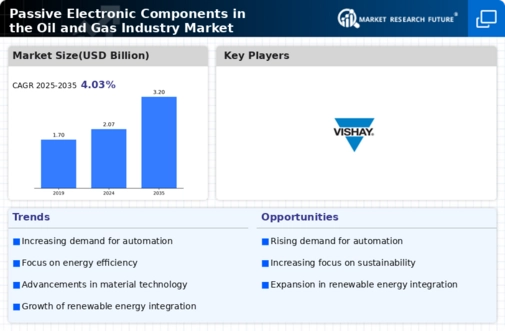Market Growth Projections
The Global Passive Electronic Components in the Oil and Gas Industry Market is projected to experience substantial growth in the coming years. With an anticipated market value of 2.07 USD Billion in 2024, the industry is set to expand significantly, reaching an estimated 3.2 USD Billion by 2035. This growth trajectory indicates a robust compound annual growth rate (CAGR) of 4.04% from 2025 to 2035. Such projections reflect the increasing reliance on passive electronic components in various applications within the oil and gas sector, driven by technological advancements, safety requirements, and evolving market dynamics.
Technological Advancements
Technological advancements play a crucial role in shaping the Global Passive Electronic Components in the Oil and Gas Industry Market. Innovations in materials and manufacturing processes enhance the performance and longevity of passive components. For instance, the development of high-temperature capacitors and resistors tailored for oil and gas applications is gaining traction. These advancements not only improve efficiency but also reduce maintenance costs. As the industry embraces these technologies, the market is expected to grow at a CAGR of 4.04% from 2025 to 2035, reflecting the ongoing evolution of passive electronic components in response to industry demands.
Focus on Safety and Reliability
Safety and reliability remain paramount in the Global Passive Electronic Components in the Oil and Gas Industry Market. The harsh operating conditions of oil and gas extraction necessitate components that can withstand extreme temperatures and pressures. Passive electronic components, known for their durability and low failure rates, are increasingly favored. This focus on safety is underscored by regulatory requirements and industry standards that mandate the use of reliable components. As a result, the market is likely to expand, with projections indicating a growth to 3.2 USD Billion by 2035, driven by the need for dependable electronic solutions.
Increasing Demand for Automation
The Global Passive Electronic Components in the Oil and Gas Industry Market experiences a notable surge in demand due to the increasing automation of processes. Automation enhances operational efficiency and safety, particularly in remote and hazardous environments typical of oil and gas operations. As companies strive to reduce human intervention, the reliance on passive electronic components, such as resistors and capacitors, becomes essential. This trend is projected to contribute to the market's growth, with the market value expected to reach 2.07 USD Billion in 2024, reflecting a growing recognition of the role of these components in automation technologies.
Regulatory Compliance and Standards
Regulatory compliance and adherence to industry standards significantly impact the Global Passive Electronic Components in the Oil and Gas Industry Market. Governments and industry bodies impose stringent regulations to ensure safety and environmental protection in oil and gas operations. Passive electronic components must meet these standards to be utilized in critical applications. This necessity drives manufacturers to innovate and improve their products, fostering a competitive market landscape. As compliance becomes increasingly complex, the demand for high-quality passive components is expected to rise, further propelling market growth.
Growing Investment in Renewable Energy
The Global Passive Electronic Components in the Oil and Gas Industry Market is influenced by the growing investment in renewable energy sources. As oil and gas companies diversify their portfolios to include renewable energy projects, the demand for passive electronic components in hybrid systems increases. These components are vital for energy conversion and management in renewable applications. The shift towards sustainability is likely to drive innovation and adaptation within the market, as companies seek to integrate passive components into new energy solutions, thereby expanding their market presence and contributing to overall growth.












